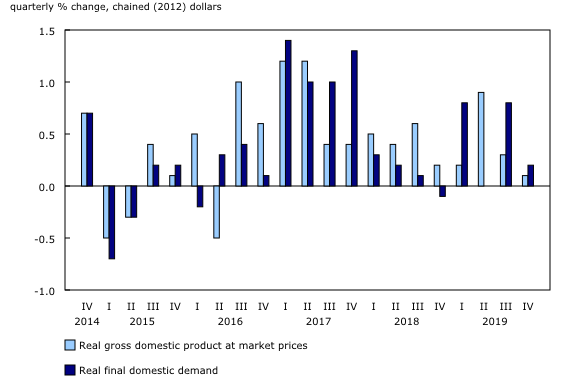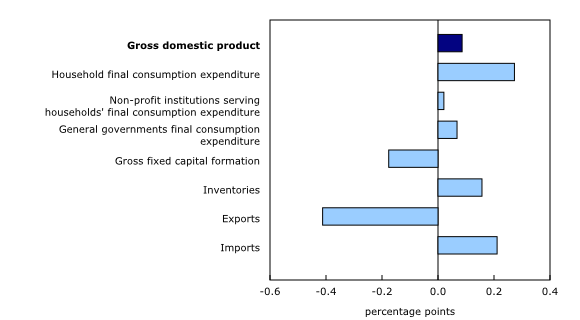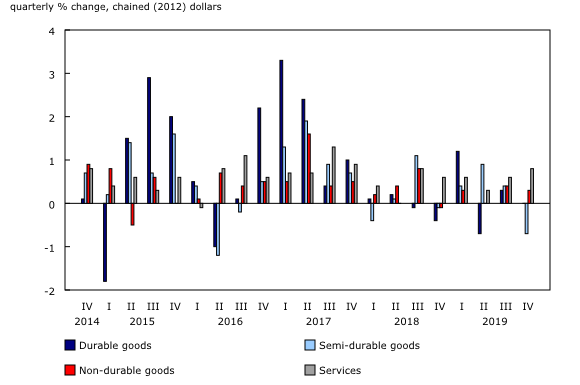Gross domestic product, income and expenditure, fourth quarter 2019
Archived Content
Information identified as archived is provided for reference, research or recordkeeping purposes. It is not subject to the Government of Canada Web Standards and has not been altered or updated since it was archived. Please "contact us" to request a format other than those available.
Released: 2020-02-28
Growth in real gross domestic product (GDP) slowed to 0.1% in the fourth quarter, owing to a decrease in business investment and weak international trade. These declines were offset by increased household spending. Final domestic demand edged up 0.2%, after rising 0.8% in the third quarter.
The annual growth rate of Canada's real GDP was 1.6% for 2019, a deceleration from the 2.0% growth in 2018. By comparison, real GDP in the United States increased 2.3%.
The slowing of Canada's fourth quarter GDP was influenced by several factors, including pipeline shutdowns, unfavourable harvest conditions, rail transportation strikes, impacts on motor vehicle and parts manufacturing from the United Auto Workers' strike in the United States, and continued global trade tensions and market uncertainty.
A strong increase in household spending on services (+0.8%) pushed overall growth into positive territory. Businesses accumulated $10.5 billion of inventories, partly attributable to supply chain disruptions. The economy-wide stock-to-sales ratio increased from 0.850 in the third quarter to 0.862 in the fourth quarter.
Household spending remains strong
Growth in overall household spending (+0.5%) stemmed from household spending on services (+0.8%). Notable increases occurred in imputed rents of owner-occupied housing (+0.6%), paid rents (+0.7%), food and beverage services (+0.4%), air transport (+2.3%) and telecommunication services (+1.0%).
Outlays on durable goods were flat in the quarter as higher spending on new trucks, vans and sport utility vehicles (+0.8%) was offset by declines in new passenger cars (-3.8%) and used motor vehicles (-0.7%). Additionally, outlays for semi-durable goods decreased 0.7%, while non-durable goods edged up 0.3%.
Housing market softens
Growth in housing investment slowed to 0.3%, after rising 3.1% in the third quarter.
Growth in investment in new construction decelerated sharply from 3.9% in the third quarter to 0.6% in the fourth quarter. While construction of single-unit dwellings fell, construction of multiple-unit dwellings continued to grow, led by several major apartment projects in Ontario. Ownership transfer costs were up 3.5%, after increasing 7.7% in the third quarter, largely driven by resale activities in British Columbia, Quebec, and Ontario. Renovation activities (-2.2%) declined for the second consecutive quarter.
Non-residential business investment falls
Business investment in machinery and equipment (-3.6%) declined for the third consecutive quarter. Notable decreases occurred in aircraft and other transportation equipment (-10.5%) and in trucks and buses (-10.9%).
Investment in engineering structures was down 1.1%, after rising 3.2% in the previous quarter. Investment in non-residential buildings rose 1.5% in the fourth quarter, following a 1.2% increase in the third quarter. Investment in intellectual property products was down (-0.8%).
Export volumes continue to decline
Export volumes fell 1.3% in the fourth quarter, the second consecutive quarterly decline. Import volumes were down 0.6%, the third consecutive quarterly decrease. Export volumes weakened substantially in farm and fishing products (-10.2%), crude oil and bitumen (-5.3%), and passenger cars and light trucks (-4.6%).
Declines in import volumes were notable in aircraft and parts (-8.8%), passenger cars and light trucks (-2.9%), and industrial machinery and equipment (-3.6%). Increases in imports of travel services (+2.5%) and commercial services (+1.4%) pushed total service import growth to 1.7%.
Terms of trade improve slightly
Import prices fell 0.5% in the fourth quarter, while export prices rose 0.3% largely because of a 2.5% increase in the prices of exported crude oil and crude bitumen. Consequently, the terms-of-trade—the ratio of the price of exports to the price of imports—rose 0.8%. Improved terms-of-trade contributed to growth in gross national income (+0.4%), which captures the real purchasing power of income earned by Canadian-owned factors of production.
The GDP implicit price index, which reflects the overall price of domestically produced goods and services, rose 1.0%.
Household disposable income increases
In nominal terms, a 1.2% rise in compensation of employees boosted household disposable income by 1.3% in the fourth quarter. Household final consumption expenditure grew 1.0%, and the household saving rate was 3.0%.
Annual GDP growth slows in 2019
The slowdown in annual growth from 2.0% in 2018 to 1.6% in 2019 was largely due to weaker international trade and investment declines.
Housing investment fell 0.6%, with a 3.4% decline in new construction partly offset by a 5.8% rise in ownership transfer costs. Business investment in non-residential structures was up 0.9%, while investment in machinery and equipment declined 1.4%, and investment in intellectual property products fell 4.7%.
Growth in export volumes slowed from 3.1% in 2018 to 1.2% in 2019, while growth in import volumes slowed from 2.6% to 0.3%. GDP growth was driven by robust household spending on services (+2.1%). Household spending on durable goods grew 0.6% in 2019, the lowest rate since 2009 (-3.0%).
In nominal terms, growth in GDP slowed slightly—from 3.9% in 2018 to 3.6% in 2019. The labour market remained resilient in 2019, resulting in a 4.4% rise in compensation of employees. This rise outpaced the increase in household spending (+3.3%) and raised the household saving rate to 2.7% in 2019.
Sustainable development goals
On January 1, 2016, the world officially began implementing the 2030 Agenda for Sustainable Development—the United Nations' transformative plan of action that addresses urgent global challenges over the next 15 years. The plan is based on 17 specific sustainable development goals.
Data on gross domestic product, income and expenditure are an example of how Statistics Canada supports the reporting on the global sustainable development goals. This release will be used to measure the following goals:


Note to readers
Percentage changes for expenditure-based statistics (such as household spending, investment, and exports) are calculated from volume measures that are adjusted for price variations. Percentage changes for income-based statistics (such as compensation of employees and operating surplus) are calculated from nominal values; that is, they are not adjusted for price variations.
There are two ways of expressing growth rates for gross domestic product (GDP) and other time series:
- Unless otherwise stated, growth rates represent the percentage change in the series from one quarter to the next, such as from the third quarter of 2019 to the fourth quarter of 2019.
- Quarterly growth can also be expressed at an annual rate by using a compound growth formula, similar to the way in which a monthly interest rate can be expressed at an annual rate. This growth rate is cited for comparisons with the United States. Both formulas represent the latest period-to-period quarterly growth.
For information on seasonal adjustment, see Seasonally adjusted data – Frequently asked questions.
For more information on gross domestic product, see the video "What is Gross Domestic Product (GDP)?"
Revisions
Data on GDP for the fourth quarter have been released along with revised data from the first, second and third quarters of 2019. These data incorporate new and revised data, as well as updated data on seasonal trends.
Real-time tables
Real-time tables 36-10-0430-01 and 36-10-0431-01 will be updated on March 9.
Next release
Data on GDP by income and expenditure for the first quarter will be released on May 29.
Products
The data visualization product "Infrastructure Statistics Hub," part of the series Statistics Canada — Data Visualization Products (71-607-X), is now available.
The product Cannabis Stats Hub (13-610-X) is now available.
The Economic Accounts Statistics portal, accessible from the Subjects module of our website, features an up-to-date portrait of national and provincial economies and their structure.
The User Guide: Canadian System of Macroeconomic Accounts (13-606-G) is available.
The Methodological Guide: Canadian System of Macroeconomic Accounts (13-607-X) is available.
Contact information
For more information, or to enquire about the concepts, methods or data quality of this release, contact us (toll-free 1-800-263-1136; 514-283-8300; STATCAN.infostats-infostats.STATCAN@canada.ca) or Media Relations (613-951-4636; STATCAN.mediahotline-ligneinfomedias.STATCAN@canada.ca).
- Date modified:





